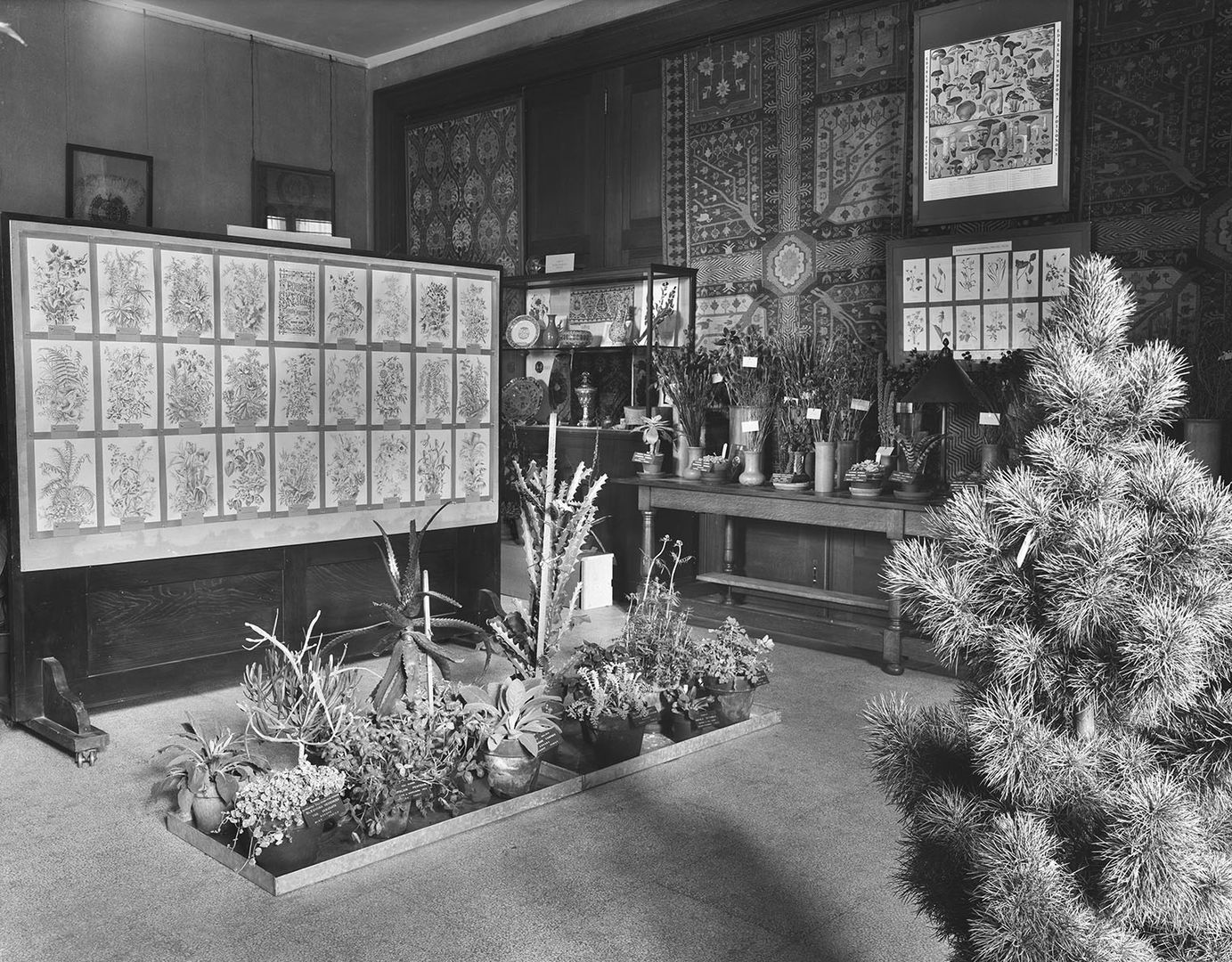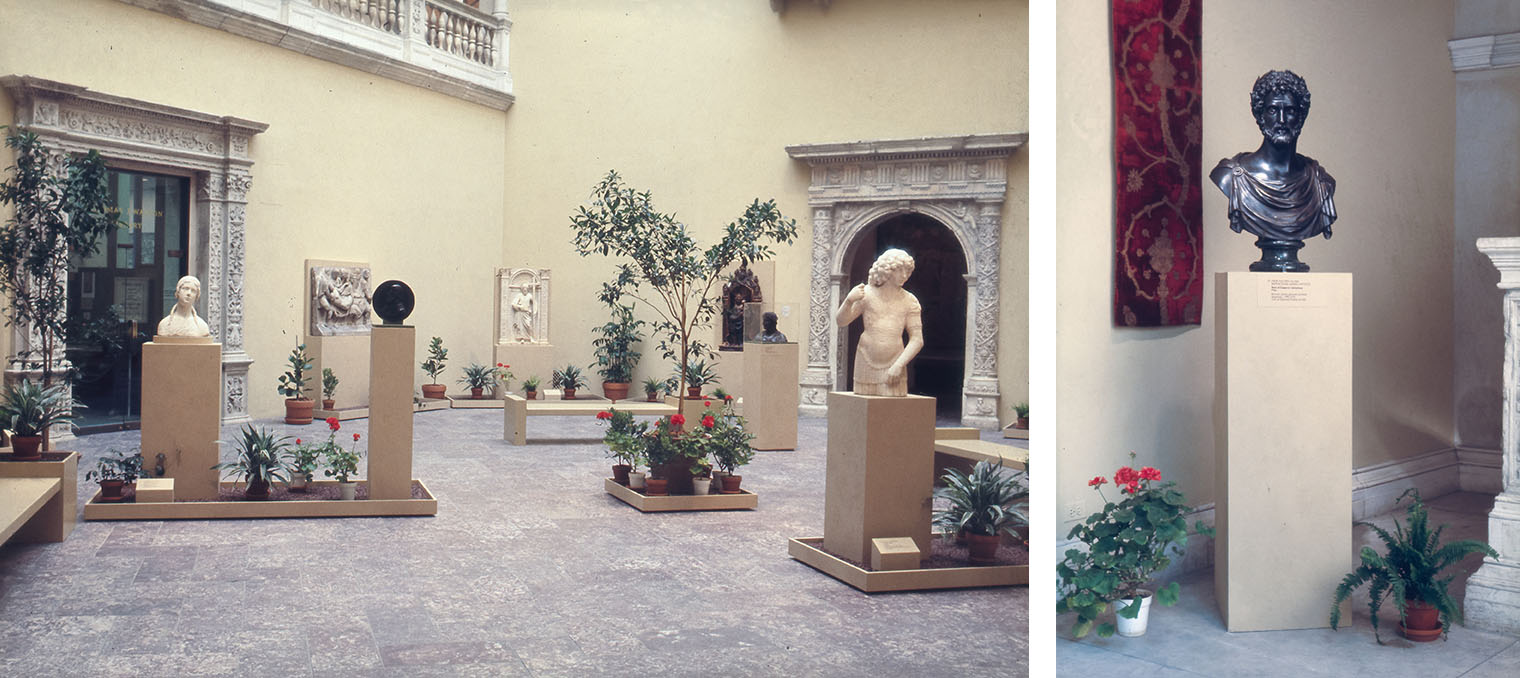Since The Met’s founding in 1870, there have been more than 2,500 exhibitions at the Museum. The Collection Information team manages a treasure trove of data and images from across all curatorial departments, covering more than one hundred years of the Museum’s history.
We recently completed a large-scale digitization of more than 45,000 gallery images from over a century, scanning historic black-and-white and color slide images of our past exhibitions. They provide a nostalgic peek into how objects were displayed and how our galleries have transformed over time, going all the way back to the early exhibitions of the 1880s. Many people may not know, for example, that our current staff cafeteria was once part of the Costume Institute galleries or that the current Japanese gallery used to be an open balcony overlooking the Temple of Dendur.
As more and more images were added, I started to notice how often plants have been used in gallery spaces. Today plants are not present in many galleries since they can attract insects and other pests, risks that have become better understood over time through conservation work and scientific research. But in years past, plants were frequently brought in as decorative elements and, in some cases, as exhibition objects. These photographs illuminate changing tastes in design and the various uses of plants in indoor spaces.

Contemporary German Art, January 4–February 22, 1909
An early exhibition on Contemporary German Art in 1909 included a collection of potted plants and ferns on the floor along with several small potted trees. A few fallen leaves can be seen on the gallery floor in the lower right. In 1919 Plant Forms in Ornament opened, focusing on plant motifs used in textiles, prints, pottery, and metalwork from across Europe, North America, and Asia. The exhibition included a broad selection of living plants provided by the New York Botanical Garden. The exhibition catalogue lists papyrus, aloes, and some fifty palms as some of the plants that were placed throughout the gallery space. 1

Plant Forms in Ornament, March 15–April 20, 1919
Building on the 1919 show, another Plant Forms in Ornament exhibition was organized in 1933. Larger in scope and scale, the Museum continued its collaboration with the New York Botanical Garden and also partnered with the Brooklyn Botanic Garden. Both institutions provided a variety of living plants, and the New York Aquarium even supplied live fish for a small pool of aquatic plants included in the exhibition.

Plant Forms in Ornament, May 8–September 30, 1933
Later exhibitions used plants as purely decorative additions to the galleries. Beginning in 1917, The Met held a series of shows focused on contemporary American design. The Architect and the Industrial Arts: An Exhibition of Contemporary American Design, the eleventh exhibition in the American Industrial Art Series, opened in 1920 and was organized by several leading architects of the time, including Eliel Saarinen, Ely Kahn, Joseph Urban, and John W. Root.

Conservatory. The Architect and the Industrial Arts: An Exhibition of Contemporary American Design (11th Exhibition), February 11–September 2, 1929
Each architect created a specific room and oversaw every aspect of its design: the furniture, the layout, and all decorative features. The elegantly appointed spaces appeared like miniature movie sets in detail and décor. Joseph Urban designed the conservatory, which he described in the catalogue as “…conceived as a semi-outdoor room where one lounges in sunlight surrounded by flowers and small shrubs.”2 Potted flowers were placed throughout the tile-floored space along with tall slender plants, including at least one bamboo. Urban also added vines of ivy on the slanted glass roof.
The fifteenth in the American Industrial Art series, Contemporary American Industrial Art, was held in 1940. As with previous shows, the exhibition was organized by a group of contemporary designers and architects, including Donald Deskey, Ralph Walker, and Walter Dorwin Teague. Edward D. Stone designed a dining alcove, which included a bamboo trellis with hanging plants and wall-mounted stepped containers with more potted plants.

Dining Alcove. Contemporary American Industrial Art, April 30–September 15, 1940
The use of plants in galleries reached a peak in the 1970s and early 1980s. Early Renaissance Sculpture from Northern Italy, 1440–1540 opened in June 1973. The exhibition was held in the Vélez Blanco patio and featured more than forty works. Potted geraniums and other plants were placed throughout the gallery. The patio space was described in the accompanying publication as “temporarily transformed into a gardenlike setting…”.3

Left: Early Renaissance Sculpture from Northern Italy, June 5–November 30, 1973. Right: Installation view of the bust of Emperor Antoninus Pius
Also held in the Vélez Blanco patio was an installation featuring the then new acquisition of Bernini’s sculpture Bacchanal: Faun Teased by Children in 1977. Plants abound in the gallery, the sculpture’s pedestal encircled with a base of ferns, with large potted palms placed around a corner fountain.

Left: A Faun Teased by Children: A New Bacchic Group by Gian Lorenzo Bernini, March 16–June 12, 1977. Right: Installation view of Bacchanal: A Faun Teased by Children, photographed in 1977
In January 1976, as part of the nation’s bicentennial celebrations, the Museum opened A Bicentennial Treasury: American Masterpieces from the Metropolitan. Part of the exhibition included a space with iron benches and large vases with potted palms and small ferns placed on the carpeted floor, reflective of the decorative use of plants in interior design that flourished during the ’70s.

A Bicentennial Treasury: American Masterpieces from the Metropolitan, January 29, 1976–January 2, 1977
Ferns seemed to have been a popular choice for the galleries. For the Frank Lloyd Wright at The Metropolitan Museum of Art exhibition in 1982, potted ferns were placed subtly atop dividing walls, providing green accents throughout the show.

Left: Frank Lloyd Wright at the Metropolitan Museum, December 3, 1982–February 27, 1983. Right: Frank Lloyd Wright at The Metropolitan Museum
Today plants can still be seen in a few spaces around the Museum: the Lehman wing courtyard, the Astor Court, and the floral arrangements in the Great Hall. We hope to put the Museum’s full exhibition records online in the near future so everyone can view this fascinating record of The Met’s history.
Notes
1. “The Exhibition of Plant Forms Used in Design,” Journal of the New York Botanical Garden, 20 (April 1919) 84–85.
2. Joseph Urban, “Conservatory” in The Architect and the Industrial Arts: An Exhibition of Contemporary American Design (New York: The Metropolitan Museum of Art, 1929), 39.
3. Olga Raggio, in Early Renaissance Sculpture from Northern Italy, 1440–1540 (New York: The Metropolitan Museum of Art, 1973), unpaginated.
Marquee: Early Renaissance Sculpture from Northern Italy, June 5–November 30, 1973




















